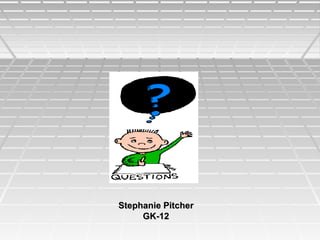
What isa sensorsimplified
- 1. Stephanie Pitcher GK-12
- 2. SENSORS Are devices capable of detecting change: Temperature Pressure Humidity Speed And Many more … There are many types of sensors used for various applications that detect different types of measurands Example: Area of application Environment – monitor air pollution Type of measurands Chemical – gas type and concentration Thermal – temperature
- 3. HUMAN SENSES [Vision, hearing, smell, taste, touch] Human senses help detect change How they enhance our ability to detect change Your senses consist of a very narrow band of what is possible, but there are devices that help people sense things beyond their capabilities or limitations Examples: Each of our senses need a certain amount of energy to work properly Light must be a certain brightness to see sound must be loud enough to hear The pressure on our skin must be great enough to feel. The skin must be sensitive enough to detect the difference in temperature--hot or cold.
- 4. HUMAN VISION Human Eye 4,100Å (violet) to 6,600Å (red) (400-600nm) http://www.predictive-maintenance.com/electrical.html
- 5. VISION TESTS
- 6. “VISION” SENSORS Importance: Sight is limited to the visible light spectrum Devices are used to detect waves beyond the human range Night vision goggles – creates images in the infra-red range X-ray machines – creates images with the very short x-ray wavelengths There are environmental parameters that are important to our welfare and survival that cannot be sensed by the human senses An example: radioactivity, UV exposure, etc.
- 7. SOUND SENSORS Importance: human hearing is limited Microphones can detect sound at extremely low volumes Ultrasound devices detect sounds at very high frequencies Communication Whales, submarines
- 8. SMELL SENSORS Human smell is limited to a certain number of chemical compounds in the air Electronic Noses Air quality (NASA project, industry – medical) Foods (fish, fruit, etc.) Wines Smoke detectors There are environmental parameters that are important to our welfare and survival that cannot be sensed by the human senses examples: carbon monoxide, radon, etc.
- 9. HUMAN BODY -TASTE- There are four tastes that can be recognized by the tongue: sweet, sour, bitter, and salty. Most of what we experience as taste is actually from our sense of smell. Particular scents and tastes are due to different molecules that bind to smell and taste receptors. Our smell receptors can recognize thousands of different scent molecules.
- 10. TASTE SENSORS Human taste requires direct contact with the compound Taste sensor Example: Litmus paper – can tell if a compound is acidic or a base Water quality (sensors that sample the water) -pollution, ecoli, etc. Fish freshness Females have more taste buds than males Taste is the weakest of the five senses
- 11. FEEL SENSORS Humans can detect change in temperature relative to the environment A human or a sensor needs to be "calibrated." There are differences between people and between cultures in the way the human "sensors" are "calibrated." For example, an Eskimo might call a room "too hot" that a person from New York calls "just right." Sensors relating to - pressure, temperature and gravity Thermometers, wind speed, motion detectors, etc. Magnetic field sensors Some birds and fish can sense the earth’s magnetic field, humans seem unable to (we use compasses) Electric Fields Sharks and eels seem to be able to, humans cannot (electrometers)
- 12. IMPORTANCE OF SENSORS There are inventions or devices that can extend the human physical senses of sight, hearing, taste, smell, touch (pressure, temperature and gravity). To appreciate the role of the environmental sensors by considering them as an extension of human senses. Sensors sense the same phenomena as human senses, but: they are there 24 hours a day they are there 365 days a year their measurements are more precise (sensitive & selective) their measurements are reproducible
- 13. SENSORS IN EVERYDAY LIFE Automobiles Cell Phones Remote Controls Traffic Lights Appliances (stove, refrigerator, furnace, thermometer) Motion Sensors Smoke Detectors Gas Detectors
- 14. VERNIER LABPRO O2 SENSOR
- 15. VERNIER LABPRO O2 SENSOR How it works O2 Gas Sensor measures oxygen levels using an electrochemical sensor (meaning it detects a chemical change by measuring electrical properties ) Chemical reaction generates a current that is proportional to the oxygen level current is measured across a resistance to generate a small voltage output voltage output is conditioned and read by the Vernier interface
- 16. Questions???